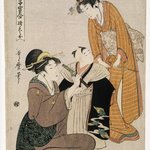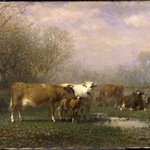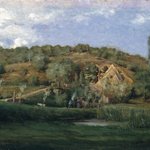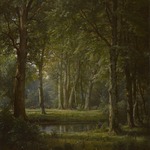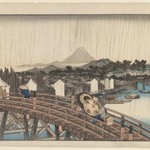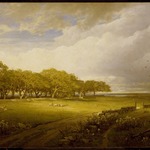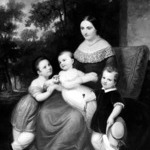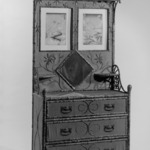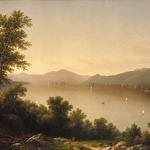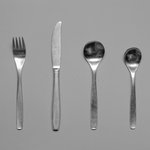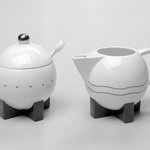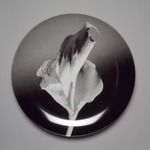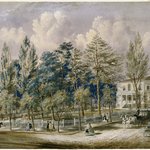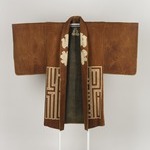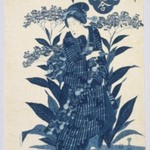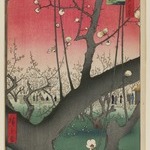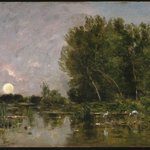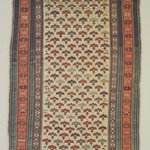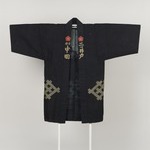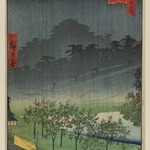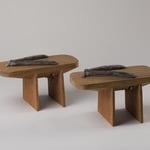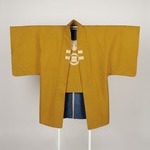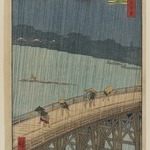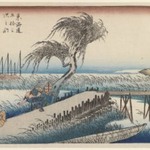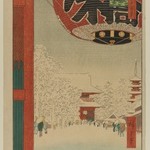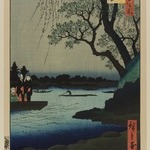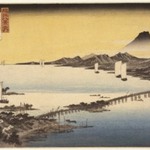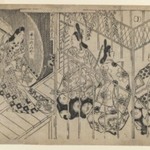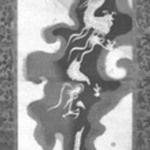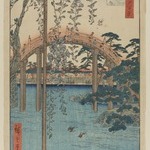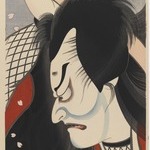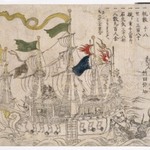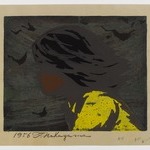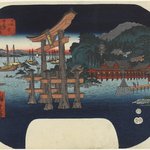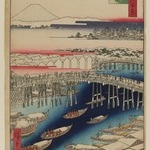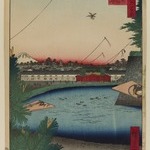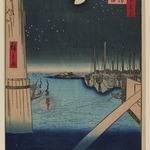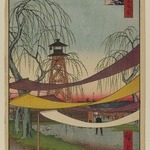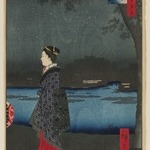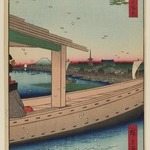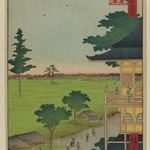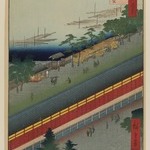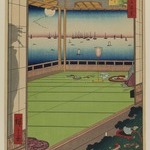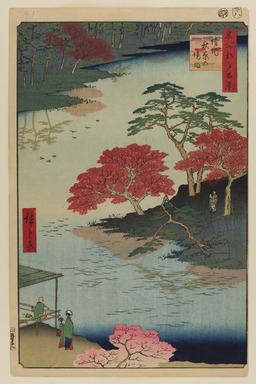
Inside Akiba Shrine, Ukeji, No. 91 from One Hundred Famous Views of Edo
Utagawa Hiroshige
Asian Art
In this view of Akiba Shrine in the village of Ukeji, Hiroshige again uniquely handles a Western visual effect: the reflection of trees in water. The artist has carefully muted the colors of the trees as they appear in reflection so that the green of the pines is lightened and the red of the maples is softened to a light pink. Perhaps by coincidence, the bright red of the maple leaves is appropriate to the nature of the deity worshiped at this site: the god of Akiba Shrine, who protects against fire. The red pigment used for the maples here is different from the red lead or iron oxide that has blackened in numbers 88 and 94, so this is the only print in the series in which the original glory of the autumn colors can still be fully enjoyed.
MEDIUM
Woodblock print
DATES
8th month of 1857
PERIOD
Edo Period, Ansei Era
DIMENSIONS
Sheet: 14 3/16 x 9 1/4 in. (36 x 23.5 cm)
Image: 13 3/8 x 8 3/4 in. (34 x 22.2 cm) (show scale)



MARKINGS
Publisher: Shitaya Uo Ei. Date and censor seal s at top margin.
SIGNATURE
Hiroshige-ga
COLLECTIONS
Asian Art
ACCESSION NUMBER
30.1478.91
CREDIT LINE
Gift of Anna Ferris
PROVENANCE
Prior to 1930, provenance not yet documented; by 1930, acquired by Anna Ferris of Summit, NJ; 1930, gift of Anna Ferris to the Brooklyn Museum.
Provenance FAQ
CATALOGUE DESCRIPTION
The fire god of Akiba Shrine, located in the village of Ukeji, east of the Sumida River, was very popular among the wives and ladies-in-waiting of the daimyo estates of Edo for protection against fire. Within the shrine grounds are many green pines and vermillion maples, particularly beautiful in the late autumn. In the water reflection the green of the pines becomes yellowish and the red of the maples is softened to a light pink. This is the only print in the series in which the brilliant autumn colors are fully enjoyed; the red pigment used here is different from the red lead which blackened in prints 88 and 94. The author has proposed that the figure of the priest seated in the teahouse in the lower left, sketching the autumn foliage, may very well be Hiroshige himself. He became a lay priest in the Third Month of 1856, at the age of sixty, just at the time this series began to appear. In 1882, twenty-five years after the artist's death, a stone memorial was erected here by Hiroshige III, the last in the direct Hiroshige line, which was engraved with the artist's parting verse and a small image of the artist in priest's robes inscribing a poem. The memorial was destroyed in the great earthquake of 1923.
EXHIBITIONS
MUSEUM LOCATION
This item is not on view
CAPTION
Utagawa Hiroshige (Japanese, 1797–1858). Inside Akiba Shrine, Ukeji, No. 91 from One Hundred Famous Views of Edo, 8th month of 1857. Woodblock print, Sheet: 14 3/16 x 9 1/4 in. (36 x 23.5 cm). Brooklyn Museum, Gift of Anna Ferris, 30.1478.91 (Photo: Brooklyn Museum, 30.1478.91_PS20.jpg)
IMAGE
overall, 30.1478.91_PS20.jpg. Brooklyn Museum photograph, 2023
"CUR" at the beginning of an image file name means that the image was created by a curatorial staff member. These study images may be digital point-and-shoot photographs, when we don\'t yet have high-quality studio photography, or they may be scans of older negatives, slides, or photographic prints, providing historical documentation of the object.
RIGHTS STATEMENT
No known copyright restrictions
This work may be in the public domain in the United States. Works created by United States and non-United States nationals published prior to 1923 are in the public domain, subject to the terms of any applicable treaty or agreement.
You may download and use Brooklyn Museum images of this work. Please include caption information from this page and credit the Brooklyn Museum. If you need a high resolution file, please fill out our online application form (charges apply).
The Museum does not warrant that the use of this work will not infringe on the rights of third parties, such as artists or artists' heirs holding the rights to the work. It is your responsibility to determine and satisfy copyright or other use restrictions before copying, transmitting, or making other use of protected items beyond that allowed by "fair use," as such term is understood under the United States Copyright Act.
The Brooklyn Museum makes no representations or warranties with respect to the application or terms of any international agreement governing copyright protection in the United States for works created by foreign nationals.
For further information about copyright, we recommend resources at the United States Library of Congress, Cornell University, Copyright and Cultural Institutions: Guidelines for U.S. Libraries, Archives, and Museums, and Copyright Watch.
For more information about the Museum's rights project, including how rights types are assigned, please see our blog posts on copyright.
If you have any information regarding this work and rights to it, please contact copyright@brooklynmuseum.org.
RECORD COMPLETENESS
Not every record you will find here is complete. More information is available for some works than for others, and some entries have been updated more recently. Records are frequently reviewed and revised, and we welcome any additional information you might have.
